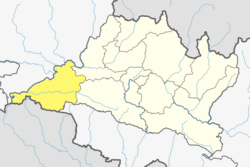Bairiya बैरिया | |
|---|---|
Village | |
| Coordinates: 27°34′34″N84°31′54″E / 27.576178°N 84.531785°E | |
| Country | |
| Zone | Narayani Zone |
| District | Chitwan District |
| Province | Bagmati |
| Government | |
| • Type | Municipality |
| • Ward President | Kul Prasad Bhushal |
| Population (1991)Increased | |
• Total | 2,936 |
| • Density | 1,200/km2 (3,000/sq mi) |
| Time zone | UTC+5:45 (Nepal Time) |
| Area code | 056 |
[1] Bairiya is a village in Ward No. 9 of Rajpur Municipality, Rautahat District, in the Narayani Zone of central Nepal. According to the 1991 Nepal census, it had a population of 2,936 people living in 527 households. Over the years, the population has grown, and most residents follow the Islamic religion. While literacy challenges remain, many people are actively working to improve education, and significant development initiatives are underway.


